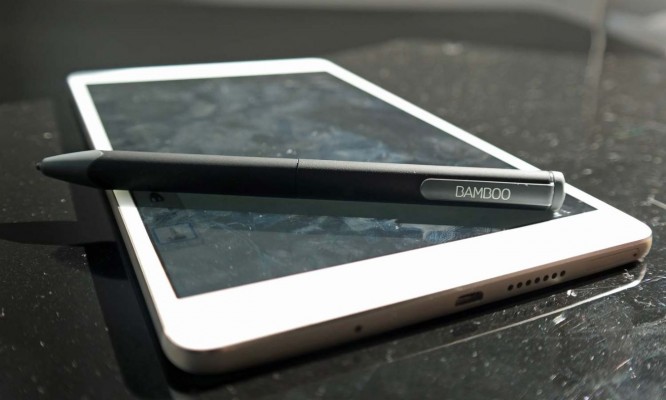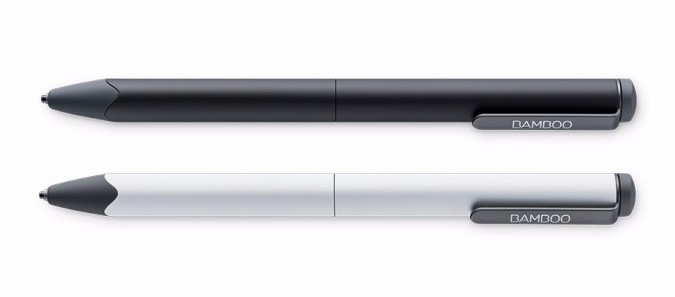Bamboo Omni Stylus Brings Fine Tip to Any Touch Screen
I've always agreed with Steve Jobs that for most touch screens, even tablets, the best stylus is the one connected to your hands. Unless a device like the iPad Pro or Galaxy Note has an active pen, I've never considered writing on it. However, for the millions of people who want to scribble on a touch-screen device that doesn't come with a pressure-sensitive active pen, there's a whole ecosystem of capacitive styli that enable you to write in this way. They do so by effectively emulating a human finger.

Unfortunately, to conduct electricity like your finger does, capacitive styli need bulbous, rubbery ends that don't feel particularly comfortable. Wacom's Bamboo Omni uses electricity to solve this problem, so the stylus can have Bic-like 1.9mm tip, which makes device feel more like a real pen. The downside? You have to remember to charge it. The stylus will cost $50 and will come in black and white versions when it releases this November.
But is it enough to make me want to take notes by hand on an iPad or Android tablet?
The Bamboo Omni uses reflective electrostatic (RES) technology to make its thin point work on a touch screen. Whereas unpowered capacitive styli require an insulating material (like rubber) that's wide enough to be recognized by a screen, the Omni broadcasts a signal out from the tip to trick capacitive touch screens into thinking the pen is covering the necessary larger area. The simple version of the explanation is that it's pretty darn accurate.
MORE: Our Favorite Tablets for Work and Play
I had to get acclimated to pressing the Omni down harder than I'm used to doing with other styli. I was far more accurate, but it took a while before I felt confident that I wasn't going to scratch a screen (for the record, I never did). Navigating iOS on my iPad Mini 2 was a breeze, and my writing and drawing in the Notes app were more accurate than if I had used my finger. Scrolling, however, was far more difficult compared to using my own digits.
The Omni's biggest weakness is its limited ability to penetrate screen protectors. I had to press down even harder to make the pen work with a protector on, which was less comfortable than using a naked screen. In addition, the plastic sheet occasionally caused the screen to lose track of the stylus, which could mean missing a letter or number when I was taking quick notes.
Stay in the know with Laptop Mag
Get our in-depth reviews, helpful tips, great deals, and the biggest news stories delivered to your inbox.

Before I used the Omni, though, I had to charge it by connecting to a micro USB port. Wacom says that the stylus takes about 2 hours to charge, which I found to be accurate. But that's a long time to wait to use your stylus (even if you're only charging occasionally), especially if your tablet is your primary computer.
The power is only for the accuracy (but you need to turn the stylus on to use it at all), and the Omni doesn't need to be paired over Bluetooth or Wi-Fi. I switched from my tablet to a phone and back again seamlessly.
The Omni is 5.6 inches long and feels more like a pen than a stylus, albeit not an expensive one. The soft-touch matte plastic on the bottom half of the stylus combined with the pen's slightly triangular shape make it comfortable to hold, but it doesn't feel like a premium product (or even a $50 one).
If you already take notes with another capacitive stylus, the Bamboo Omni is probably an upgrade over the thick-tipped pen you have now. Omni's device looks and feels more like a pen than the cheap styli that flood the market. But if you're just thinking about getting a stylus for your tablet or phone, the combination of the $50 price, having to press hard and needing to avoid screen protectors makes this a less appealing choice.
Tablet Guide
- Kids Tablets to Buy (or Avoid)
- 10 Tablets with the Longest Battery Life
- Tablet Buying Guide: 8 Essential Tips
- The Best Tablets for Less Than $200
- Chromebook vs. Tablet: Which Should You Buy?
- Why 4G Tablets Are a Total Rip-Off
- How to Sell, Trade In or Donate Your Old Tablet
- iPad Buying Guide: Which One is Right for You?
- How to Use Your iPad as Your Only PC
Andrew is a contributing writer at Laptop Mag. His main focus lies in helpful how-to guides and laptop reviews, including Asus, Microsoft Surface, Samsung Chromebook, and Dell. He has also dabbled in peripherals, including webcams and docking stations. His work has also appeared in Tom's Hardware, Tom's Guide, PCMag, Kotaku, and Complex. He fondly remembers his first computer: a Gateway that still lives in a spare room in his parents' home, albeit without an internet connection. When he’s not writing about tech, you can find him playing video games, checking social media and waiting for the next Marvel movie.
